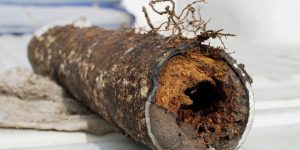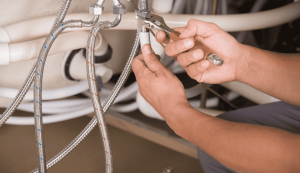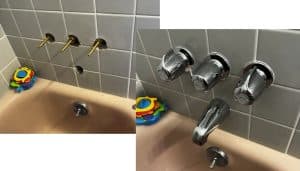
Nothing is more frustrating than weak water pressure when you’re trying to take a shower or wash dishes. Low water pressure can be a symptom of various plumbing issues, from clogged pipes to faulty fixtures. Identifying the root cause can help you enjoy better water flow and avoid more serious plumbing problems down the road.
At Flow Pros Plumbing, we specialize in diagnosing and fixing water pressure issues. This guide will help you understand common causes of low water pressure and how you can address them, whether through simple DIY fixes or professional solutions from our plumbing experts.
1. Clogged Pipes
Over time, mineral buildup, debris, and even rust can accumulate inside pipes, gradually restricting water flow and lowering water pressure. This is particularly common in areas with hard water, where minerals like calcium and magnesium can build up quickly.
How to Address Clogged Pipes
- DIY Solution: If the clog is mild, you can try flushing pipes with a mixture of vinegar and baking soda. This can help break down some mineral deposits in smaller pipes.
- Professional Cleaning: For more serious buildup, a professional plumber can perform a deep cleaning or use specialized tools to clear clogs effectively. If clogs are widespread or recurring, it might indicate a need for repiping.
For persistent low water pressure due to clogs, consider Flow Pros’ professional repair services or repiping services, which can restore optimal water flow in your home.
2. Corroded Plumbing
In older homes, plumbing pipes may be made of materials like galvanized steel, which can corrode over time. Corrosion reduces the inner diameter of the pipes, restricting water flow and leading to a noticeable drop in water pressure. This issue tends to worsen with age, as corrosion continues to build up.
Signs of Corroded Pipes
- Discolored Water: Rusty or yellow-tinged water can indicate corroded pipes.
- Low Pressure at Multiple Fixtures: If several fixtures have low pressure, it could be a sign that corrosion is affecting your main water lines.
How to Fix Corroded Pipes
The best solution for corroded plumbing is often repiping with modern materials, like copper or PEX, which are more resistant to corrosion. Replacing old pipes not only restores water pressure but also improves water quality.
Flow Pros offers expert repiping services to help upgrade your plumbing system and eliminate issues caused by pipe corrosion.
3. Faulty Pressure Regulator
A pressure regulator is a valve that controls the water pressure entering your home. If this device malfunctions or is set incorrectly, you might experience either low or excessively high water pressure. A faulty regulator is a common cause of sudden changes in water pressure and can affect all fixtures in the house.
How to Identify and Fix Pressure Regulator Issues
- Check Your Pressure: Attach a pressure gauge to an outdoor spigot and measure the reading. Ideally, it should be between 40-60 psi. If it’s significantly lower or fluctuates, the pressure regulator might be the issue.
- Adjust or Replace the Regulator: Some regulators can be adjusted with a simple turn of a screw, while others may need replacement if they’re worn out.
For assistance with diagnosing and replacing a faulty pressure regulator, Flow Pros Plumbing offers reliable repair services to restore optimal water pressure in your home.
4. Leaks in the Plumbing System
Leaks are another common culprit behind low water pressure. When water escapes from pipes before it reaches its destination, you may notice reduced pressure at your faucets and showerheads. Leaks can occur in various places, including walls, ceilings, and underground, making them difficult to detect without the right tools.
How to Identify and Address Plumbing Leaks
- Check for Damp Spots and Water Damage: Look for signs of water stains, mold, or damp areas, which could indicate a hidden leak.
- Use Your Water Meter: Turn off all faucets and appliances, then check your water meter. If the meter continues to run, there may be an undetected leak.
- Professional Leak Detection: Since hidden leaks can be challenging to locate, professional help is often the best choice.
Flow Pros offers specialized leak detection services to help find and repair hidden leaks quickly. For slab leaks or more complex issues, we also provide slab leak detection services, ensuring minimal damage and disruption to your home.

5. Issues with the Water Supplier
Sometimes, low water pressure is beyond your control and may stem from problems with your local water supplier. Repairs, maintenance, or unexpected issues on the municipal water system can temporarily lower water pressure in your area. This is especially likely if you notice that your entire neighborhood seems to be affected.
How to Identify Supplier-Related Water Pressure Issues
- Ask Neighbors: If multiple homes nearby are experiencing low pressure, it’s likely a supplier issue.
- Check with Your Water Utility: Contact your water supplier to confirm any ongoing maintenance or repairs that might be affecting service.
- What to Do in the Meantime: If water pressure issues from the supplier are causing inconvenience, using stored water or limiting heavy water usage can help until service is fully restored.
If the issue isn’t resolved with your supplier or if it seems isolated to your home, it may be time to reach out to a professional. Our residential plumbing services at Flow Pros can help assess the problem and offer solutions if the issue is closer to home.
6. Clogged or Malfunctioning Fixtures
Sometimes, low water pressure is isolated to a single faucet or showerhead rather than the whole house. In these cases, mineral deposits and debris buildup within the fixture itself are often to blame. Over time, small particles in the water supply can clog faucet aerators and showerhead nozzles, restricting water flow.
How to Fix Clogged or Malfunctioning Fixtures
- Clean the Aerator or Showerhead: Unscrew the aerator from your faucet or remove the showerhead, then soak it in vinegar to dissolve any mineral buildup. After soaking, scrub it with a brush to remove stubborn particles.
- Replace Old Fixtures: If cleaning doesn’t resolve the issue, it may be time to replace the fixture. Modern fixtures are often designed to prevent buildup and maintain good water flow.
If these DIY methods don’t work or if fixtures around the house are all experiencing low pressure, Flow Pros Plumbing offers professional help for installation and repairs to restore optimal flow to your fixtures.

7. Broken or Partially Closed Shut-Off Valve
The shut-off valve controls water flow into your home and is usually located near the main water line. If the valve is only partially open or has malfunctioned, it can restrict water flow, resulting in low water pressure throughout the house. In some cases, the valve may also have become damaged or stuck over time.
How to Check and Adjust the Shut-Off Valve
- Locate the Valve: Find the main shut-off valve (usually near where the main water line enters your home). There may also be individual shut-off valves for different fixtures.
- Ensure It’s Fully Open: If you’re experiencing low pressure, check the main shut-off valve to ensure it’s fully open. Turn the handle counterclockwise to open it completely.
- Inspect for Damage: If the valve appears corroded or hard to turn, it might be damaged. In this case, replacing it can help restore full water pressure and ensure reliable operation.
For assistance with shut-off valves or for emergency plumbing services, Flow Pros Plumbing can inspect, repair, or replace faulty valves to help you maintain steady water flow throughout your home.
Conclusion
Low water pressure can be caused by various issues, from clogs and leaks to faulty fixtures and pressure regulators. By understanding the common causes and knowing how to troubleshoot them, you can often resolve minor problems on your own. However, more complex issues like corroded pipes, hidden leaks, or a faulty shut-off valve are best handled by a professional plumber to ensure a thorough, lasting fix.
If you’re experiencing persistent low water pressure, don’t hesitate to reach out to Flow Pros Plumbing. Our team specializes in diagnosing and repairing low water pressure issues through services like leak detection, repiping, and more. Contact us today for expert solutions to restore full water pressure and keep your plumbing system running smoothly.



